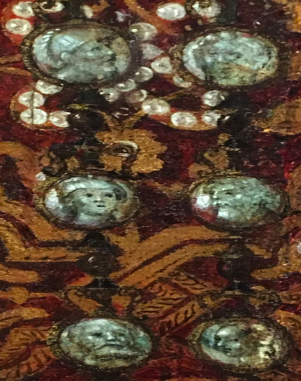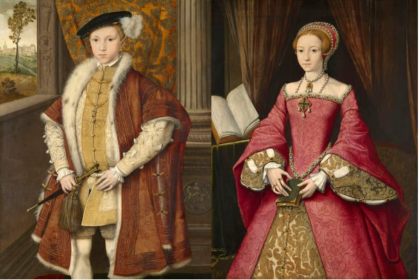Catherine Parr was a true Renaissance queen. The Renaissance was literally a time of the rebirth of Classical knowledge and learning, and humanists venerated the wisdom of Ancient scholars, spending their time translating and philosophising of the surviving texts. And of course, this fascination with Antiquity was reflected in other areas of society, such as art, literature, even dress. Catherine was very engaged with humanist scholars and participated in humanist activities such as the study of languages and the translation of classical texts. This appreciation of classical learning can even be seen in her portraiture.
The National Portrait Gallery houses a portrait of Catherine painted by Master John, an artist we know little about except he unusually seems to have been English born, and he had an incredible eye for detail in his work. The portrait is dated to 1545, a year or two into her third marriage to Henry VIII, and is one of three contemporary portraits of Catherine that are extant (for more on Catherine’s contemporary portraits, see my post here: https://tinyurl.com/2p973nph). It is a beautiful portrait, however it is very easy to miss the exquisite detail work that has gone into it. I certainly did, until I read the wonderful Nicola Tallis’ ‘All The Queen’s Jewel’s, 1445-1548,’ which discusses the minutiae of the jewels of the Tudor queens, as can be found in a whole range of different records, including inventories and portraits.

Image from Nicola Tallis’ ‘All the Queen’s Jewels, 1445-1548,’ PhD thesis.
Several aspects of this particular portrait are highlighted by Nicola, but I think the most fascinating are the girdle beads hanging from Catherine’s waist. At first glance, they seem like any other girdle beads – a standard accessory for any Tudor lady – but once you get up close and personal to the portrait, it becomes clear that each bead is a cameo face.
Cameos were very fashionable, very valuable, and very rare during this period. They most commonly depicted figures from the Ancient world, just as these ones do. In this portrait, the uniqueness of each cameo suggests that each one was supposed to represent a specific figure from Antiquity. Unfortunately their identities have not survived. From Catherine Parr’s inventories as queen we do know that she owned a number of cameos and jewels with ‘antiquez personz.’ From Catherine’s records, and by comparing inventories, we know that some of these pieces were actually inherited from her predecessors, Jane Seymour and Katherine Howard, whilst others were commissioned by Catherine herself.
That Catherine carefully selected this piece to be portrayed in is significant. It shows how much she valued her own learning, and it aligned her with the brightest minds of her day. It also showed her status, to be able to afford such a valuable item. It signalled that she was a lady of learning, and a queen that humanists could approach for patronage.
These cameo beads are such a small detail, but they speak volumes about fashion trends, the skill of the artist, and the character of Katherine herself.
(Header Image: Portrait of Catherine Parr attributed to Master John, c.1545)





